Excerpts from the Rite-In-Rain Field Journal: Nepal Service Learning Trip
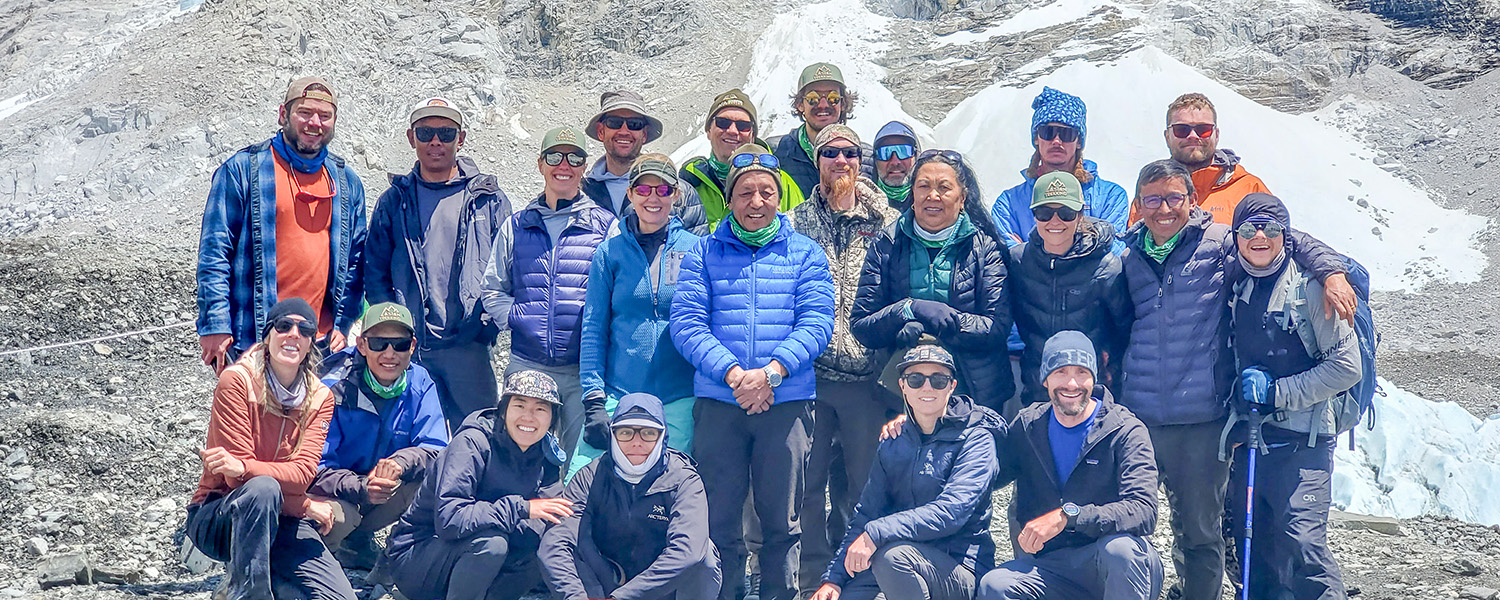
In the Spring of 2023, the Weber State Outdoor Program (OP) presented an outlandish opportunity: to travel internationally through the Khumbu, an area in the Himalaya of Nepal. This trip would be led in conjunction with the Apa Sherpa Foundation (ASF), and support the education of children in the Khumbu. A seemingly once in a lifetime opportunity, I registered for the trip the same night it opened to the public. I was able to join as a longtime staff member of the Outdoor Program and student at WSU. Below are a collection of excerpts from my field journal, highlights taken from our biggest days and most impactful events, stories told through the lens of my eyes. And at the end of these excerpts, an author's note. Thank you for reading, I hope you enjoy:
Touchdown, Kathmandu (4/20/24)
A series of international flights totaling some 30 odd hours and traveling into the future through time zones eventually lead us to the capital of Nepal. Haze from nearby fires and some pollution combined with the early morning sun to tint the world a slight orange. I'm immediately greeted by smells and sounds I've never experienced. Disoriented. Kathmandu is likely the largest city I'll ever visit. Its streets are lined with multitudes of shops ranging from food to electronics to engine repair to whatever you can imagine, eclectic and packed tightly together. What space isn't taken up by shops is filled with dwellings, apartment buildings averaging 3 stories in height. All painted different bright colors, some defying western building standards. Power lines hang in large nests, bundled together by straps of cloth and zip ties, from the power poles. I cannot seem to stop admiring the infrastructure of the city. The organized chaos feels totally foreign, yet somehow calming. The streets are shared by pedestrians, dogs, motor bikes, buses, and a surprising amount of rally cars. While they never get going faster than ~20 MPH, there seems to me no rhyme or reason to the traffic patterns. The drivers pay no heed to lanes or merging or spacing between cars. They slow down only for intersections and people directly in front of them. I completely trust everyone involved, as that's all I can do. Complete and utter faith in all of these strangers. Driver and pedestrian and shop owner and money exchanger alike, all I can do is trust these people who live on the opposite side of the world from me. What a terrifying and beautiful thought.
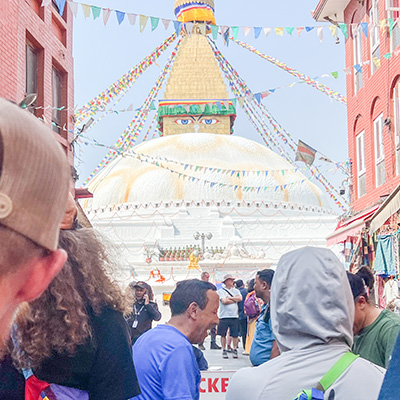
The Die is Cast (4/22/24)
Today, a 4 am start to catch our flights out of Kathmandu. Our group is so large that we have to split into 2 small planes, and luckily the ASF and our guide company, Asian Trekking, have pulled some strings and arranged for us to fly out of Kathmandu, as opposed to a 5 hour drive to another domestic airport. Supposedly we snaked the only 2 flights from Kathmandu to Lukla today. The plane is small, unassuming. Designed for short takeoffs and landings, it has 2 propeller style engines. We all cram in, sardine can style, to the small tube. Here it is- the part of this trip I was most anxious about. The Lukla Airport, our destination, is credited as the most dangerous airport in the world. My anxiety is palpable by my fellow passengers. I'm seated next to Yangjin, the lovely wife of Apa Sherpa. She's more afraid of the flight than I am. Apa says he usually charters her a helicopter into the mountains: they're apparently more comfortable in the inevitable turbulence. Not long after takeoff, Yangjin puts her head in her knees, and reaches over to grab onto my legs. I'm instantly filled with strength and determination that I did not have before, my anxiety turning to steely resolve. I hold onto her arm, trying to convey some sense of comfort, while she squeezes my knee. Together, as the 2 most anxious people on the flight, we make it through the bumpy, deafeningly loud, statistically dangerous flight. After the pilot corrects the fishtailing aircraft and lands safely on the Lukla airstrip, we share a quick smile. “We did it!” We stop in the Paradise Lodge for morning tea and breakfast. They have organized a celebration for us and Apa, who is a celebrity in the mountains. They bring out a cake. They have also organized a group of Buddhist Monks to come in. They chant a blessing for our safe journey, while we all eat our eggs silently
......
A few hours of hiking leads us to our first top in the Village of Ghat. Here, the Apa Sherpa Foundation supports a hot lunch program for children at the local school. Education here is not supported or paid for by the government, and is therefore all done privately, generally through donations. Some of the kids come from remote villages a few hours away. During the school week, some of the students will sleep at a hostel near the school to save themselves the journey - this is why the hot lunch program is so necessary and appreciated here. Some or many of the kids may not eat or be able to come to the school, otherwise. Conveniently, the kids are eating as we arrive. We stop by the lunch building so that we can see what the Foundation is supporting, the whole reason we are here from a humanitarian point of view. As we enter the lunch building, we are greeted by the children eating. Some 30 odd children. Littles, ranging in age from what seemed as young as 4 to about 13. They all shouted “Namaste!!” as each of us entered, their beaming small smiles filling the room with a light that outshines the sun. More than a few of us shed silent tears behind the thin veil of our polarized sunglasses. This is where it really hit me - this is what we're here for. Yes, I get to do this great personal journey and see another country and bla bla bla. But this is the point. Why we're here with the Foundation. This is what Apa has been working for.
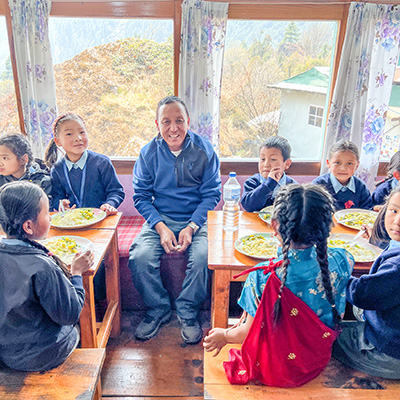
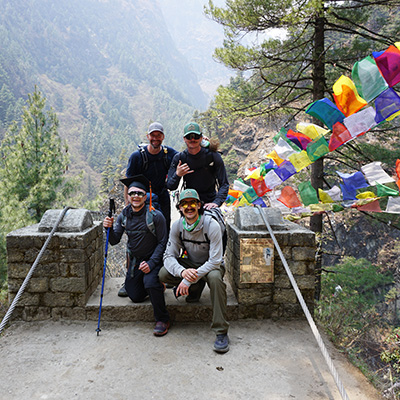
Upwards to Namche Bazaar (4/23/24)
Today is credited as our hardest hiking day. A steep vertical gain over a few miles from Phakding, eventually we run into the Hillary Bridge, and eventually the dreaded “Namche Wall”, a steep section of the trail. At the entrance to the Hillary Bridge, I met the porter carrying my bag. His name is Pasang. He's a handsome young man, smaller, stronger, and younger than me. He's 19. He's been portering for 2 years, ostensibly to help support his family financially. I'm not sure why or how he got into this line of work, as not long after we arrive, the porters are to be off again, trying to beat the group of trekkers to the next Lodge so that our bags are there by the time we arrive. The porters each crouch down, place a strap made of fabric around their forehead, and stand up hunched over. They don't carry the duffel bags in a way that westerners may consider -they bundle a few bags together with polyester rope, place their forehead straps near the top of the bundle, and carry the whole soul crushing load on their head or neck. We watch as they cross the Hillary bridge as quickly as the rickety suspension bridge allows. I don my graduation cap, as the suspension bridge will undoubtedly provide for great marketing material when we return to the States. All the while, I can't help but contemplate the differences between the lives that me and Pasang lead. I wonder if he wants to be a porter or has to be a porter. I just graduated University, I wonder if that's an opportunity that he will ever have. I think about Apa's quote “Without education, we have no choice.”. I'm forced to wrestle with this socioeconomic situation as I turn and cross the suspension bridge, one hand on my graduation cap to prevent the wind from carrying it away
.....
As one approaches Namche from lower down, you have to come around a corner made by the subridge of the mountain. All at once, the town of Namche Bazaar is in full view. Daniel, who went ahead of me, said that my first sight of Namche filled my face with the same odd mix of wonder and glee that a child might have on Christmas morning. Namche is a sight to behold, a village built on trade and commerce between other villages, sprawled out onto every semi-flat surface in sight. Lodges and shops are built onto large, human-made terraces in the side of the mountain slope. The front of the town is guarded by a large Stupa, and a line of prayer wheels that are powered by the running river. Instantly, all at once I fall in love with Namche Bazaar and everything, and everyone, in it.
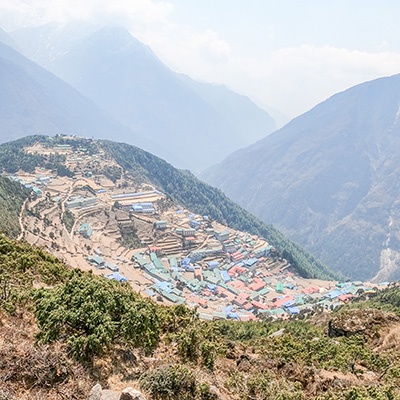
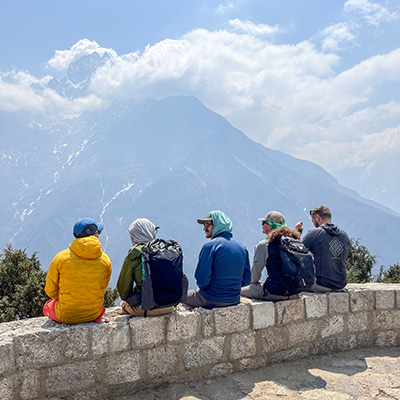
First Sight of the Beasts (4/24/24)
Acclimatization day. A few hours of hiking leads us to the Everest Viewpoint and Tenzing Norgay memorial/museum. Here we got our first look at the Beasts of mountains that the Himalaya house. In the distance, the summit pyramid of Everest is visible between gusts of wind that obscure it with snow. Just to the right, the summit of Lhotse. Standing alone, the mountain that gives me massive l'appel du vide, Ama Dablam. Ama Dablam fascinates me the most out of any Himalayan peak. It stands alone in a valley, a massive tower of rock and snow and ice. A solitary tower, with ridges that span out to either side of it. That's how it got its name - “Ama Dablam” means “Mothers Necklace”, as it resembles a woman wearing a traditional Sherpa necklace. Also of note, a fellow Ogdenite (the infamous Jeff Lowe, who I'm a huge fan of) was the first so summit the mountain solo in 1979.
A Big Day (4/26/24)
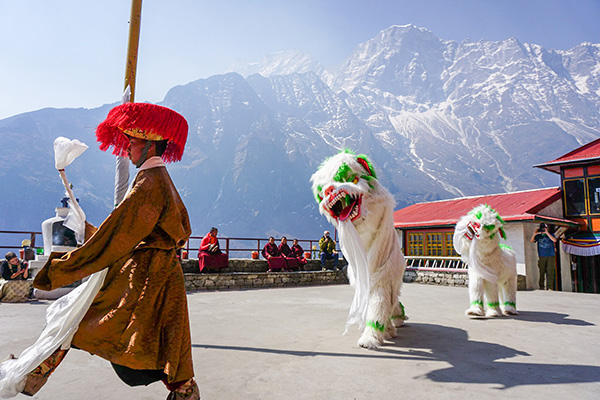 We started the morning with a visit to the Thame Monastery. As we walked up the steps to the entrance, we were greeted by some form of performance. Two Monks were dressed in a costume depicting a white snow lion With a green mane and accents. A third monk was dressed in some sort of brown tunic and hat. The three of them danced together, slowly and seemingly choreographed, to the rhythm of a drum being beat by a monk in the background. The remaining handful of Monks chanted, ostensibly in their mother tongue, of which I cannot decipher a syllable. A bit of sage burns in the center of the monks in the back. We gather around on the steps of the monastery and watch in silence until the performance ends. Apa gets up and announces to us that the Reincarnate Lama, the spiritual leader of the monastery, will come out to the steps where we are seated to meet us. They lay out a table for him to sit at, and we all line up in front of it, waiting to be blessed. We present the Lama with a Kata and a monetary donation, to which he blesses and returns the Kata to us, placing it around our necks. He presents us each with a peppercorn to consume, and another monk wraps a red cord around our necks while chanting a blessing. A most auspicious spiritual event, to be blessed by a person of such stature in the Buddhist religion. Ang Nima, our lead guide, advises us to cherish both the Kata and red cord that have been bestowed upon us.
We started the morning with a visit to the Thame Monastery. As we walked up the steps to the entrance, we were greeted by some form of performance. Two Monks were dressed in a costume depicting a white snow lion With a green mane and accents. A third monk was dressed in some sort of brown tunic and hat. The three of them danced together, slowly and seemingly choreographed, to the rhythm of a drum being beat by a monk in the background. The remaining handful of Monks chanted, ostensibly in their mother tongue, of which I cannot decipher a syllable. A bit of sage burns in the center of the monks in the back. We gather around on the steps of the monastery and watch in silence until the performance ends. Apa gets up and announces to us that the Reincarnate Lama, the spiritual leader of the monastery, will come out to the steps where we are seated to meet us. They lay out a table for him to sit at, and we all line up in front of it, waiting to be blessed. We present the Lama with a Kata and a monetary donation, to which he blesses and returns the Kata to us, placing it around our necks. He presents us each with a peppercorn to consume, and another monk wraps a red cord around our necks while chanting a blessing. A most auspicious spiritual event, to be blessed by a person of such stature in the Buddhist religion. Ang Nima, our lead guide, advises us to cherish both the Kata and red cord that have been bestowed upon us.
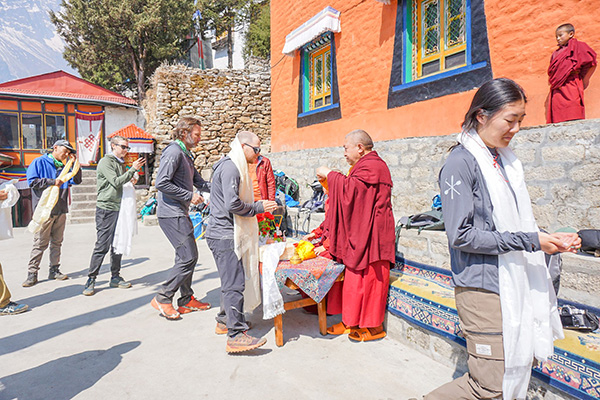
........
Next, to the Thame school, sponsored by ASF and Thule. Here there's a ceremony, where the children perform dances they choreographed themselves and the officials of the school address the crowd. They gift us each with a Kata, and we proceed to hand out donations in the form of toys and soccer jerseys to all the kids. Once all the kids have received their shirts, we start performing some manual labor carrying stones across the courtyard. The kids joined us, carrying the biggest stones they could for a few minutes before deciding it would be more productive trying to cajole the members of our group into choosing increasingly large stones. Soon enough, we were all huffing and puffing at the effort while the kids ran around us giggling. I sat to rest for a few minutes, and a boy no older than 6 sat next to me, looking at my bright white work gloves. I took one off and offered him to put his hand in. He obliged, and I closed the velcro strap around his narrow wrist. He looked at it for a moment, and then gave me a strong high-five, joining our two gloved hands. We talked for a few minutes, both swinging our legs in the air, before he decided he was bored and returned my glove, running off with another group of boys. Another few of our western group painted a large room in one of their buildings, from a faded yellow-ish beige to a deep, calming blue. Soon, my sick body ran out of energy, and I returned to the tea house for a fever nap.
......
I woke from my fever nap just in time for dinner. I donned a mask to hopefully avoid spreading my illness, though many of the others already seem to be infected. I entered the main dining room, where Hayley stopped me. “You're going to want your grad cap for this”, she said. I turned on my heel to retrieve it. Once everyone was seated, Hayley stood and made an announcement. She pointed out that today, the 26th of April, 2024, marked my official graduation from Weber State University -Bachelor of Science in Mechanical Engineering. And for Cameron, his pinning ceremony for his Paramedic Program. “Congratulations. We're proud of you”. Applause from the group. Ang Nima Sherpa brought out a cake, with white frosting, depicting mountains in the background. In all caps, “CONGRATS”, written with red jelly of some kind. I felt my face go red and beam as big a smile as I could as people took pictures and collected pieces of cake. Apa stood, and presented us both with beautiful Kata as a congratulations. I bowed my head to receive it, and stood up to see Apa's huge, room-filling smile. Apa's phrase “Without education, we have no choice” played over and over in my head. Apa allows us to take a photo in his Everest hat, a cap in the shape of Everest made out of some kind of metal? It's heavy either way. After not long, I retire to my room for more fever napping.
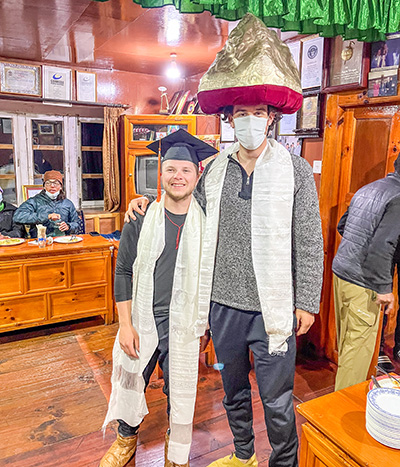
Khumbu Climbing Center (4/28/24)
Today we were able to access and get a tour of the Khumbu Climbing Center (KCC). The KCC was built in an effort by western climbers and guides to educate the people in the Khumbu who wanted to work in the mountains, so that they could gain the skills necessary to keep themselves safe. Now the instructor team is mostly built of Nepali climbers, and only a few westerner team members come to offer support. The school is funded by the Alex Lowe Foundation, and is supported by a number of outdoor brands and manufacturers as well. Each of us in the group carried a set of donations for the students of the school. Helmets, harnesses, headlamps, etc etc. Tools for them to use in the mountains, donated by Petzl. We presented them to the caretaker of the facility after our tour. Many of our group are educators in the Outdoor industry. We know how special it is to teach and share passions with others. To be in a place where such high quality education occurs, built on selflessness and love for the mountains and the people of the Khumbu, was a deeply special experience and opportunity. Some of us were moved to tears, and others couldn’t keep a smile off our face.
....
Daniel gave me an Outdoor Program sticker to leave in the KCC. I picked a spot on a support beam near the front door, just out of sight, but incredibly obvious from a certain angle. We all stood there a moment, admiring the seeming immortalization of our visit here. Our small mark on the great and growing legacy of the KCC. Daniel, Paul, Cam and I each took turns posing with it. Huge, full-toothed smiles stayed glued to our faces as we returned to monkeying around on the training equipment in the facility.
Everest Base Camp (5/2/24)
Today, Everest Base Camp. Basecamp lies above the village of Gorak Shep, a somewhat bleak and undeveloped place above 16,000 feet. The trail to basecamp is clogged with hundreds, maybe thousands of trekkers making their way up. Some are easily identified as living at or near sea level, moving at a snail's pace with hunched backs and heavy chests - but moving, all the same, towards their objective. While annoying as it slows our own progress, it is also beautiful to witness. Human perseverance, that is. Our indomitable spirit. Basecamp is about a mile long, and constitutes a village in and of itself. Made up of various sizes and volumes of 4 season tents, organized in clusters by expedition company. I queue up for a picture with the iconic “BASECAMP” rock, which has since been partially covered by a sign installed by the Nepalese government. I hop up onto the stone, don my graduation cap, and pose for a few photos. Then, the group of quick hikers spends some time waiting for our companions, gawking upwards at the enormous peaks, seracs, and glaciers. There is no photo one can take that can convey the magnitude. We are, all of us, awestruck. After some time, the remaining hikers in our group join us, and we pose for group photos.
Thank you for reading this far. A final note; please be aware that this is only a summary of the most notable individual events along the journey. There is no way to document or quantify the inside jokes we told, the small pieces of the universe we bore witness to, the beautiful people we met, the lifelong friendships we formed. While there for four weeks, it may as well have been a lifetime. A thanks to all of my travel companions, my many great friends, who were with me on this journey. A special thank you to my family for supporting my efforts, to Paul for being my battle buddy, and to Daniel, Hayley, Heather, and Apa - for all the hard work they put in to make it possible.
About The Author
Cage is a WSU alum, having graduated in Spring 2024 with a BSME. Cage has worked with the Outdoor Program at WSU for 4 years and has held every position from Rental Tech to Student Manager. These days Cage is working as a guide in the Moab area, sharing the wilderness with his guests. On his off days you can find him climbing, hiking, writing or hanging out with his friends.
Back to Blog
